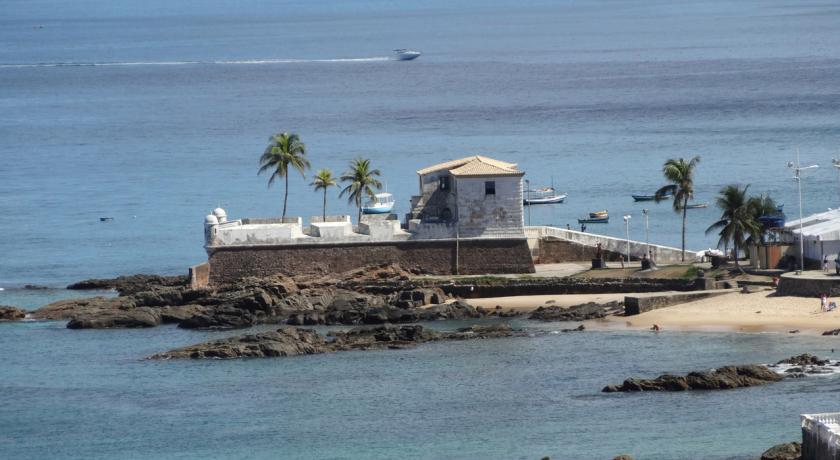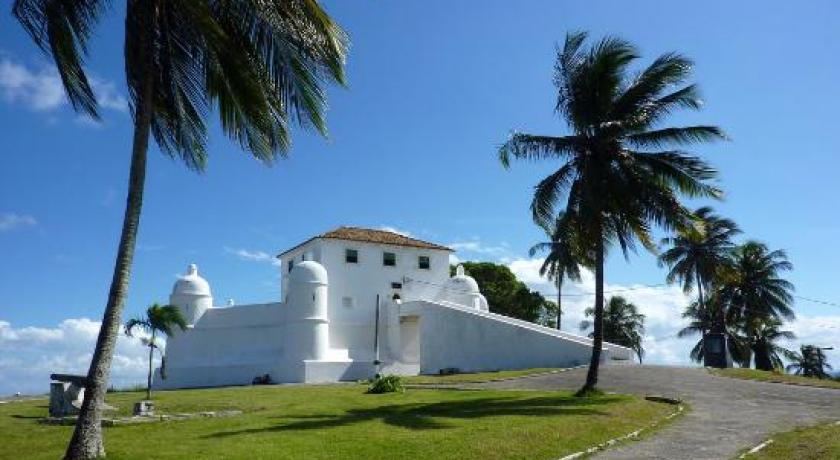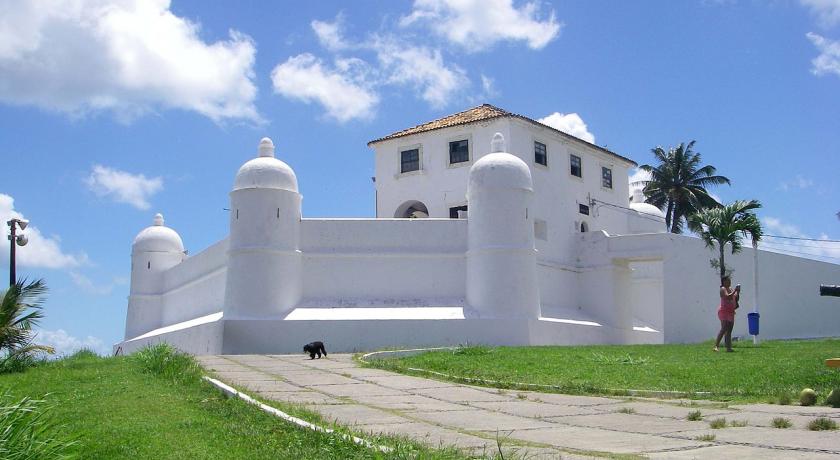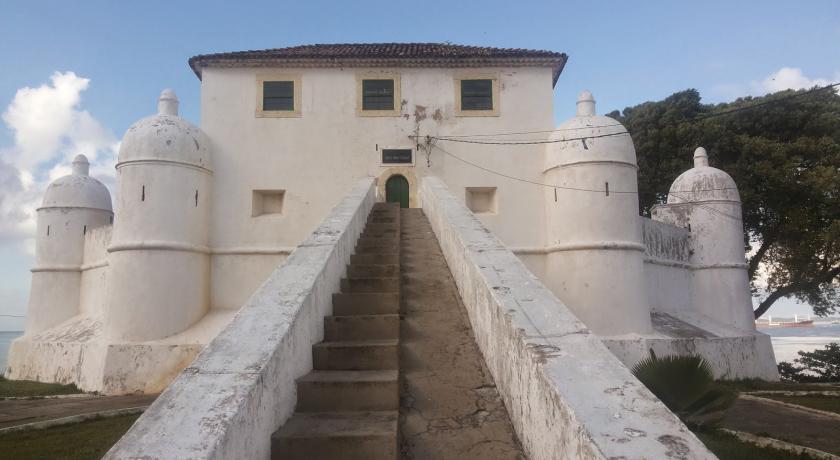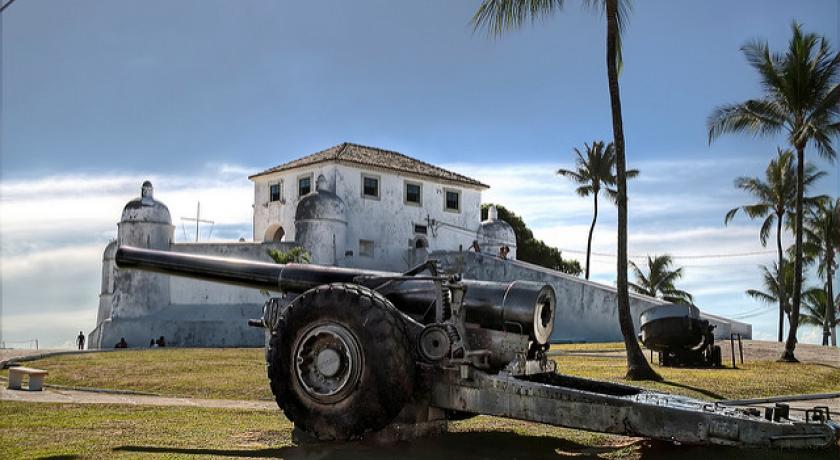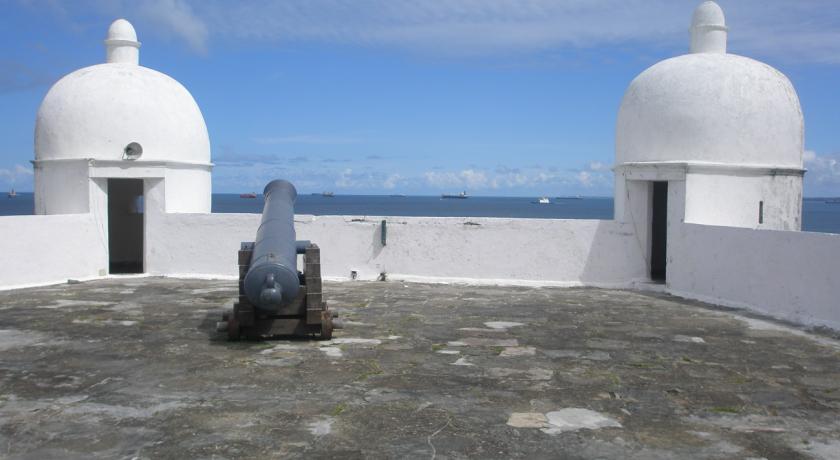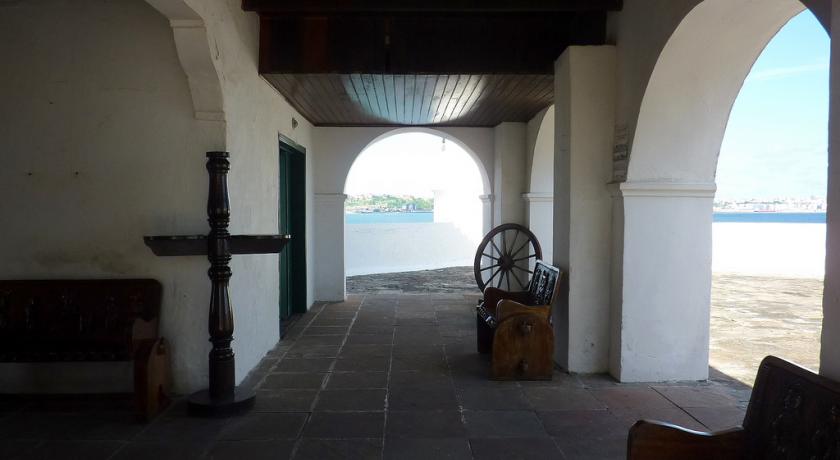Description
The Fort of Nossa Senhora de Monte Serrat is located in a dominant position at the tip of Monte Serrat, at the time of the Colony Brazil in the northern limit of the city of Salvador , present street of Boa Viagem, in the coast of the state ofBahia , Brazil .
History
The actual fort
The Governor-General, John of Lencastre (1694-1702), built the primitive fortim, in stone and lime masonry , with the planof the Florentine engineer Baccio da Filicaia . The works were only concluded, however, in 1742 , under the government of the Viceroy D. André de Melo e Castro (1735-1749).
According to the iconography of José António Caldas ( Plant and Prospect of the Fort of N. Sra. De Monserrate in: Topographic charts contains the plans and prospects of the fortresses that defend the city of Bahia de Todos os Santos and its concave by sea and land , The structure of the structure was in the shape of an irregular hexagonal polygon, with parapets to the barbeque and, at the vertices, circular guaritas covered by domes . On the embankment, on the side of the access gate, there is a two-storey building, housing the service quarters ( Casa de Comando , Barra da Tropa , Casa da Palamenta , and others), and the cistern . Originally its access was by a drawbridgebetween the ramp and the embankment, and the Guard Corps had, on the ground floor, two quarters flanking the entrance.
Also it is represented in an iconography of Carlos Julião , under the name of 1. Monserrate ( Elevaçam and fasada that shows in prospect by the navy, the city of Salvador, Bahia of all Saints, 1779. Office of Archaeological Studies of Military Engineering , Lisbon), illustrated with the drawings of typical women's costumes.
The 19th century
SOUZA (1885), reports that in 1809 he was harnessed with nine pieces. It is believed that this author was based on the " Opinion on the fortification of the Capital ", Brigadier José Gonçalves Leão , president of the Junta commissioned by the Governor of Bahia, that year, to propose the necessary works for the defense of the peninsula and the concave. BARRETTO (1958) discriminates this artillery like being eight pieces of caliber 18 pounds and one of 12.
During the Sabinada (1837-1838), it was occupied by the rioters, who used, for this purpose, the Brasilia package , which they made with two pieces. In response, the Imperial Navy sent a force of sixty marines in four boats of the Imperial Mariner frigate , which attempted to land on Boa Viagem beach on March 13 , 1838 , being repelled by intense artillery fire and rifles . The following day, the fort suffered a naval blockade by Imperial Mariner herself, by the Regeneration corvette and by the Tres de Maio brig . At the same time, by land, a detachment of the Brazilian Armycompleted the siege of the position, which, under legalistic crossfire, surrendered.
It was visited in 1859 by Emperor Pedro II of Brazil (1840-1889), who recorded in his travel diary:
- " October 28 - (...) From there [Lazareto] I went to the fortress of Monserrate, lying abandoned, having stuck the inscription that existed on the gate. It has a beautiful view and the Przewodowski, who lives nearby, said that nobody died still there with yellow fever or cholera . "
In the context of the Christie Question (1862-1865), the " Report of the State of the Fortresses of Bahia " to the President of the Province, dated August 3 , 1863 , gives it as repaired, quoting:
- " (...) Its configuration is the one of a hexagon with the development of 485 palms , to the barbeta and currently mounting six pieces of caliber 18.
- It is well maintained, clean and has the right accommodations for the material and staff.
- This Fort must therefore be considered in a state of rendering the services that are his own; being only of note that it is not armed with artillery of greater caliber, as it suits its position and distance relative to the other strong ones. "
SOUZA (1885) computes to him three pieces, dismantled, with the parapets of the walls in good condition, at the time (1885). [ 7 ]
From the 20th century to the present
The fort was repaired in 1883, and at the time of World War I in 1915 , as well as restoration works by the Ministry of War in 1926 , executed at the request of the then governor of the State of Bahia, Francisco Marques de Gois Calmon (1924-1928 ), which preserved its original characteristics.
The historical site of Monte Serrat / Boa Viagem (church and fort) has been listed by National Historical and Artistic Heritage since 1957 . According to BARRETTO (1958), the premises of the fort were occupied at the time by the SRMB of the 6th Military Region. In the decade of 1980 it hosted the Bahia Section of the Brazilian Amateur Radio Emission League .
Administered by the 6th Military Region of the Brazilian Army and restored, since 1993 it houses the Museum of the Armaria , exposing to the public several firearms, including cannons. His garrison is dressed in the historical uniform of the 1st Infantry Regiment of Bahia , within the project of revitalization of the Historical Strengths of Salvador, of the Secretariat of Culture and Tourism in partnership with the Army.
A commemorative plaque, on the left side of the Gate of Arms, reminds visitors:
- " On July 17, 1624, the Dutch general John van Dorth was killed in this place, IGHB , 1938 "
For the aficionados of telecartofilia , its façade and access illustrate a phone card from the Fortes de Salvador series, issued by Telebahia in June 1998 .
Source: https://pt.wikipedia.org/wiki/Forte_de_Nossa_Senhora_de_Monte_Serrat
Address
Salvador
Brazil
Lat: -12.929809570 - Lng: -38.517692566


